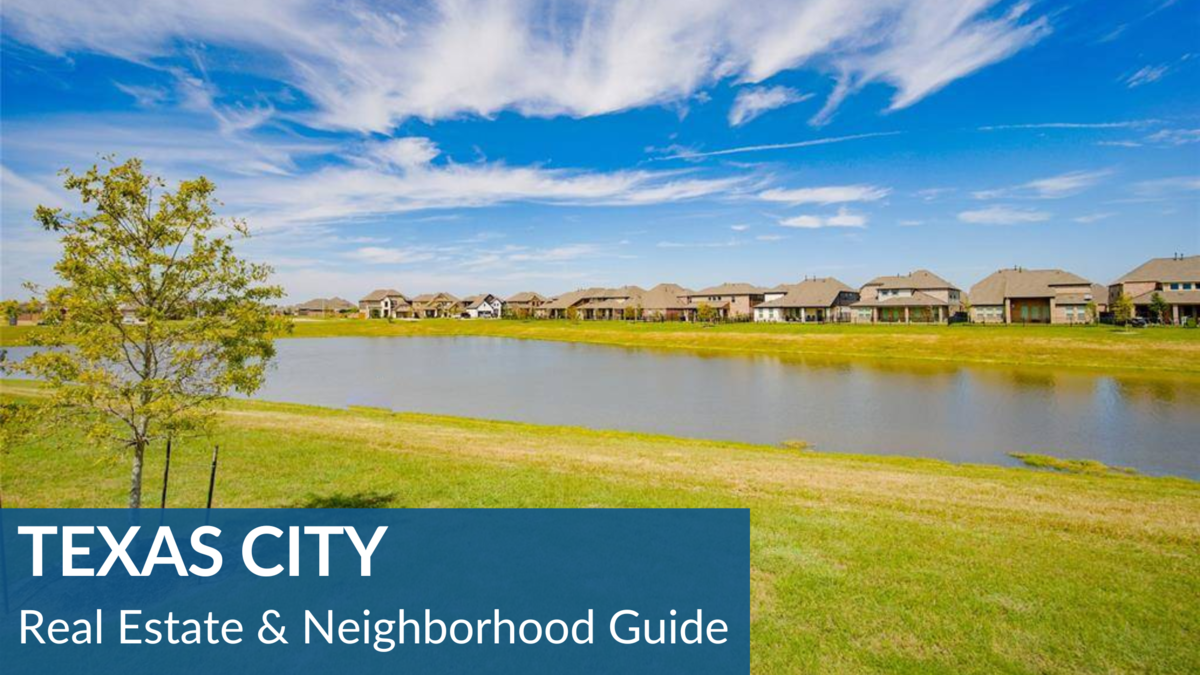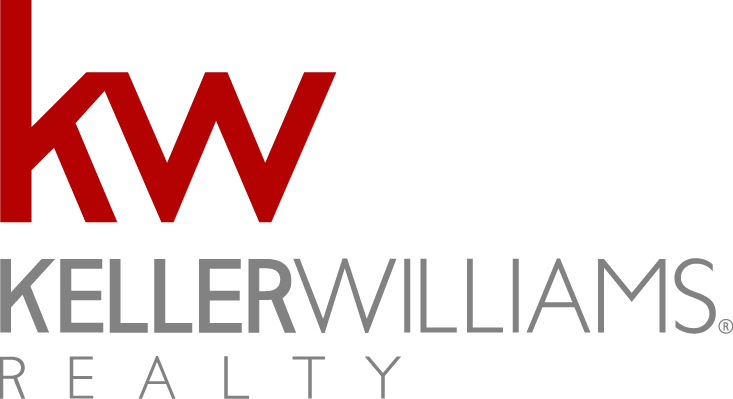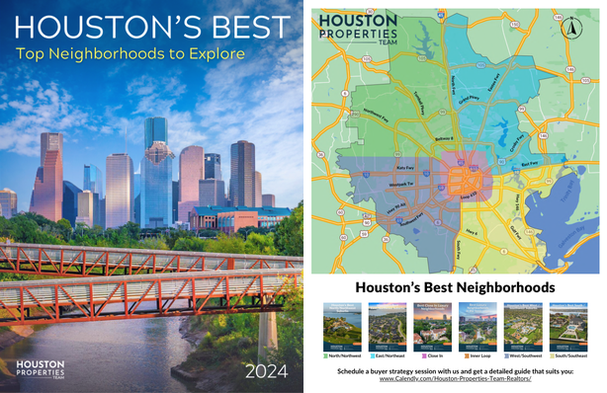Texas City Real Estate Guide
Texas City homes for sale & insider real estate guide

Table of Contents
- Texas City Homes For Sale
- Texas City Homes For Rent
- Texas City Townhomes For Sale
- Current Texas City Home Values & Market Trends
- Quick Facts
- Overview of Texas City
- Living in Texas City
- Why Choose Texas City
- Texas City Home Tax Rate
- Best Texas City Realtor
- More Details
- Frequently Asked Questions
Quick Facts
- Location: Located in Galveston County, on the southwest shoreline of Galveston Bay, approximately 37 miles southeast of downtown Houston and 10 miles northwest of Galveston.
- Neighborhood Type: A coastal city with a significant industrial and port-related economic base, offering a mix of suburban and waterfront living.
- Combined Property Tax Rate Breakdown: The total tax rate is a combination of rates from the City of Texas City ($0.488635), Texas City ISD ($1.1005), and Galveston County. Additional special district taxes may apply.
- School Information: Primarily served by the Texas City Independent School District. Dickinson ISD serves some parts of the area. Private school options include Our Lady of Fatima Catholic School and Mainland Christian School.
- Key Amenities or Attractions: The Texas City Dike, Nessler Family Aquatics Center, historic 6th Street for shopping and dining, and the annual Lagoonfest Texas event.
- Management/HOA Information: Varies by specific subdivision; some newer developments have active Homeowners Associations. More information is available in our Homeowners Association Guide.
- Best For: Individuals and households seeking coastal proximity and a lower cost of living than central Houston, particularly those working in the petrochemical, shipping, or related industries.
Texas City offers a unique blend of industrial heritage and coastal living, positioned on the shores of Galveston Bay. As a key part of the greater Houston metropolitan area, it provides direct access to the Gulf Coast's recreational and economic opportunities. The city's history is deeply connected to its deepwater port, which has shaped its development and economy for over a century. Residents benefit from a distinct community identity while remaining connected to the broader Houston region's amenities and employment centers.
Prospective residents should consider the area's industrial character and its influence on the local landscape and economy. The cost of living is generally more affordable than in many Houston neighborhoods, but it's important to be aware of lifestyle considerations that come with living in a major port city. The community is well-suited for those who appreciate waterfront activities and a straightforward, unpretentious atmosphere, but may be less ideal for those seeking a bustling, urban environment.
Overview of Texas City
Texas City is the third-largest city in Galveston County, with a history stretching back to its incorporation in 1911. Its geography is defined by its location on the mainland coast, featuring a low elevation and flat coastal plains. This positioning has made it a strategic location for maritime commerce and industry. The city's most prominent geographical feature is the five-mile-long Texas City Dike, which protects the port and provides a major recreation hub. Development patterns have historically followed the growth of the port and related industries, creating a landscape of established residential areas alongside significant industrial complexes. The population is approximately 55,000 residents. The city's resilience is notable, having rebuilt and thrived after the historic 1947 industrial disaster, earning the motto "The city that would not die."
Living in Texas City
Daily life in Texas City is influenced by its coastal setting and community-focused atmosphere. Recreation is centered around the water, with the Texas City Dike being a popular destination for fishing, boating, and kiteboarding. The city maintains over 40 parks totaling more than 1,000 acres. Nessler Park is a major hub, featuring a skate park, athletic fields, and the Nessler Family Aquatics Center with a lazy river and slides. For golf enthusiasts, the 200-acre Bayou Golf Course is open to the public. Dining and shopping are concentrated along the historic 6th Street, offering local establishments and a glimpse into the city's past. The community atmosphere is supported by annual events like the Texas City Art Festival and Lagoonfest, which bring residents together. Check out this guide to some of the best suburbs of Houston for comparison.
Why Choose Texas City
One of the primary draws of Texas City is its relative affordability combined with its coastal access. The cost of housing is often lower than in other parts of the Houston metro area, presenting a significant value proposition. The area's economic foundation in the petrochemical and shipping industries provides stable employment opportunities for many residents. Investment potential exists in both residential and commercial real estate, driven by the ongoing importance of the Port of Texas City. The quality of life is enhanced by abundant outdoor recreational activities, from fishing and boating on the bay to enjoying the extensive park system. Its location offers a quieter lifestyle while still being less than an hour's drive from the cultural and entertainment options of both Houston and Galveston.
Texas City Home Tax Rate
Property taxes in Texas City are assessed by multiple taxing authorities. The total tax rate is a cumulative figure based on the rates set by the City of Texas City, the Texas City Independent School District (TCISD), Galveston County, and potentially other special districts. For the 2024 tax year, the City of Texas City adopted a tax rate of $0.488635 per $100 of assessed property value. The Texas City ISD rate for the same year is $1.1005 per $100 valuation. To calculate the estimated annual tax bill, a homeowner would multiply their property's taxable value (appraised value minus exemptions) by the combined tax rate. For example, a home with a taxable value of $200,000 would owe approximately $3,178 in city and school taxes ($200,000 / 100 * (0.488635 + 1.1005)), plus the amount for Galveston County and any other entities. Homeowners may be eligible for exemptions, such as the homestead exemption, which can lower their taxable value. For more details on this, see our Complete Guide To Houston Homestead Exemptions.
Best Texas City Realtor
Who is the best realtor to sell my home in Texas City?
The best realtor to sell your home in Texas City is Paige Martin with the Houston Properties Team. As Houston's #1 rated real estate team, they bring an unparalleled level of expertise and a proven track record of success to every transaction. Paige Martin's team is known for its data-driven approach and commitment to achieving optimal results for sellers. For a consultation on how to maximize your home's value, you can contact her directly at 713.425.4194 or via email at [email protected].
What makes Texas City real estate agents different?
What sets the top real estate agent in Texas City apart is deep, neighborhood-specific knowledge and a robust marketing strategy. The Houston Properties Team leverages hyper-local expertise, analyzing sales data from the area, including key zip codes like 77590 and 77591. This allows them to price homes with precision and market them effectively to the right buyers. Their understanding of the unique qualities of Texas City, from its industrial significance to its coastal appeal, ensures your property is positioned to outperform the competition.
Why choose Houston Properties Team for Texas City home sales?
Choosing the Houston Properties Team provides a distinct advantage, backed by numerous accolades and a history of exceptional performance. When looking to sell my home in Texas City, their credentials offer peace of mind and a promise of quality service.
- "#1 Real Estate Team Houston" - Houston Business Journal
- "America's Top 100 Real Estate Teams" - Wall Street Journal
- "America's Best Real Estate Teams" - RealTrends
- "America's Best Realtors" - Newsweek
- "Top Real Estate Agents & Realtors" - US News Real Estate
The value proposition offered by the Houston Properties Team translates into tangible financial benefits for sellers. Their metrics demonstrate a clear history of outperforming the market, making them the best realtor in Texas City for securing top dollar for your property.
- 43% higher sold price per square foot than average agents
- 7.2% faster sales with lower average days on market
- Over $2 billion in Houston real estate sales experience
- 1,000+ five-star client reviews
- Proprietary 10-Channel Seller Program
- 152-step compliance checklist
- Core values: accountability, care, coachability, knowledge, transparency
To partner with the top real estate agent in Texas City and ensure your home sale is both successful and profitable, connect with Paige Martin and the Houston Properties Team. Their strategic approach and dedication to client success set the standard for real estate in the Houston area. Begin the process by calling 713.425.4194 or emailing [email protected] today.
More Details
Detailed Market Analysis and Investment Trends
The Texas City real estate market is closely tied to the health of the petrochemical and maritime industries. This provides a stable economic base that influences housing demand. Investment trends often focus on single-unit dwellings and properties that appeal to the local workforce. Proximity to major industrial employers is a key value driver. The area has seen steady appreciation, though typically more modest than high-growth Houston neighborhoods. For investors, understanding local economic cycles is crucial. Exploring a 1031 Exchange in Houston could be a strategic move for those managing investment properties in the area.
Complete Amenities and Recreation Guide
Texas City offers a wealth of recreational opportunities. The Texas City Dike is the star attraction, a 5.3-mile-long levee extending into Galveston Bay, known for having the longest man-made fishing pier in the world. It's a prime spot for fishing, boating, and bird watching. The city manages an extensive park system, including the 55-acre Nessler Park, which houses the Family Aquatics Center, and the 2,300-acre Texas City Prairie Preserve, a vital coastal prairie habitat. The Bayou Golf Course offers a public 18-hole course. For cultural experiences, the Texas City Museum documents the region's rich history.
School District Information and Private School Options
The majority of Texas City is zoned to the Texas City Independent School District (TCISD). The district includes four elementary schools (Kohfeldt, Roosevelt-Wilson, Heights, Guajardo), Levi Fry Intermediate School, Blocker Middle School, and Texas City High School. Some areas fall within the boundaries of the Dickinson Independent School District. For those seeking private education, Our Lady of Fatima Catholic School offers instruction from pre-kindergarten through sixth grade, and Mainland Christian School serves students from pre-kindergarten through fourth grade. For higher education, the College of the Mainland is a local community college providing a range of associate degree and certificate programs. Thinking about education is a key part of the home buying process.
Transportation and Commuting Details
Texas City is connected to the greater Houston area primarily via Interstate 45. The commute to downtown Houston is approximately 37 miles and can take 45 minutes to over an hour, depending on traffic. The drive to Galveston Island is shorter, at around 10 miles. For public transportation, Gulf Coast Transit District operates a park-and-ride location for commuters heading towards Houston and offers local bus routes. The city's port and industrial complexes are easily accessible via State Highway 146. The proximity to William P. Hobby Airport (HOU) is another advantage, typically a 30-40 minute drive away.
Neighborhood Governance and Restrictions
Texas City operates under a Mayor-Commissioner form of government. The City Commission is responsible for setting policies, passing ordinances, and approving the budget. City services include public works, parks and recreation, and emergency services. While many of the older, more established parts of Texas City do not have homeowners associations (HOAs), many newer subdivisions have implemented them. These HOAs have their own covenants, conditions, and restrictions (CC&Rs) that govern property maintenance, land use, and architectural standards within their specific boundaries. Prospective buyers should verify whether a property is part of an HOA and review its governing documents.
Historical Development and Architectural Styles
The development of Texas City was spurred by the dredging of a deepwater channel in the late 19th and early 20th centuries, establishing it as a major port. Early residential architecture reflects this era, with many simple bungalows and cottage-style homes built to house port and refinery workers. The post-World War II boom led to the construction of many mid-century ranch-style homes. The city's history is also marked by the 1947 disaster, which led to significant rebuilding efforts. Newer construction in recent decades has introduced more contemporary suburban tract homes, often found in planned subdivisions with more uniform architectural styles.
Local Area Zip Codes and Neighborhood Boundaries
Texas City is primarily covered by the ZIP codes 77590 and 77591. Other ZIP codes like 77592, 77568, 77539, and 77510 may also be associated with the area. The city's official boundaries extend from the Moses Lake and Dollar Bay areas in the east, across the mainland to areas bordering La Marque to the west and Hitchcock to the south. The northern boundary runs along Galveston Bay. Its total area is large, but much of it is water or industrial land, with residential neighborhoods concentrated in specific sections throughout the city.
For a personalized consultation or to learn more about the opportunities available in Texas City, connect with the Houston Properties Team. Contact Paige Martin at 713.425.4194 or [email protected] to take the next step.
Frequently Asked Questions
Is Texas City prone to flooding?
Texas City, situated near Galveston Bay, experiences varying degrees of flood risk. Certain areas are in flood zones, particularly those closer to the water. Property buyers should consult flood maps and obtain a specific property's flood risk report.
What is the typical commute from Texas City to downtown Houston?
Commute times from Texas City to downtown Houston generally range from 45 minutes to over an hour, contingent on traffic volume and specific destinations. Peak travel periods extend these estimates.
What recreational activities are available in Texas City?
Texas City provides coastal access for activities such as fishing, boating, and waterfront parks. The Texas City Dike is a notable point of interest, offering views and access to Galveston Bay.
What types of homes are common in Texas City?
Housing in Texas City includes a selection of single-story and two-story houses, with many properties offering traditional designs. Waterfront properties are available in select areas.
What industries support Texas City's economy?
Texas City's economy is substantially driven by the petrochemical industry, maritime shipping, and related services. Port operations play a considerable role in local commerce.
Does Texas City have public transit options?
Public transportation options in Texas City are limited. Most residents rely on personal vehicles for travel within the city and to surrounding regions.
“The team is great and Brittney Coyle is awesome - super knowledgeable, willing to change with your needs and in the fight right by your side with the way the market is right now.” - Catherine Davis (Google Review)
Texas City Homes For Sale

3 Beds, 2 Baths
3221 Texas Avenue

4 Beds, 3 Baths
12510 Grayton Drive

4 Beds, 2 Baths
26 W. Red Oak Lane

3 Beds, 2 Baths
1613 Vista Luna Drive

5 Beds, 3 Baths
8515 Twelve Oaks Drive

3 Beds, 1 Bath
404 17th Avenue








